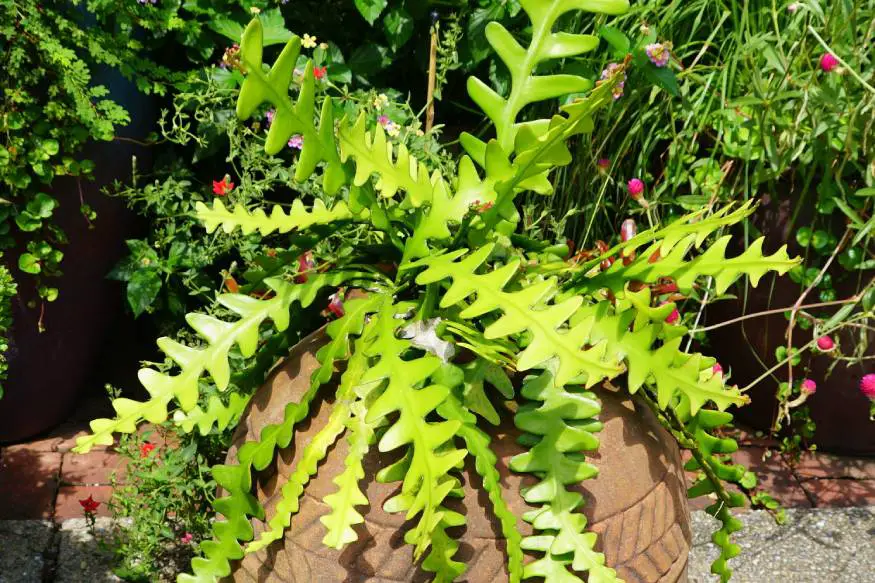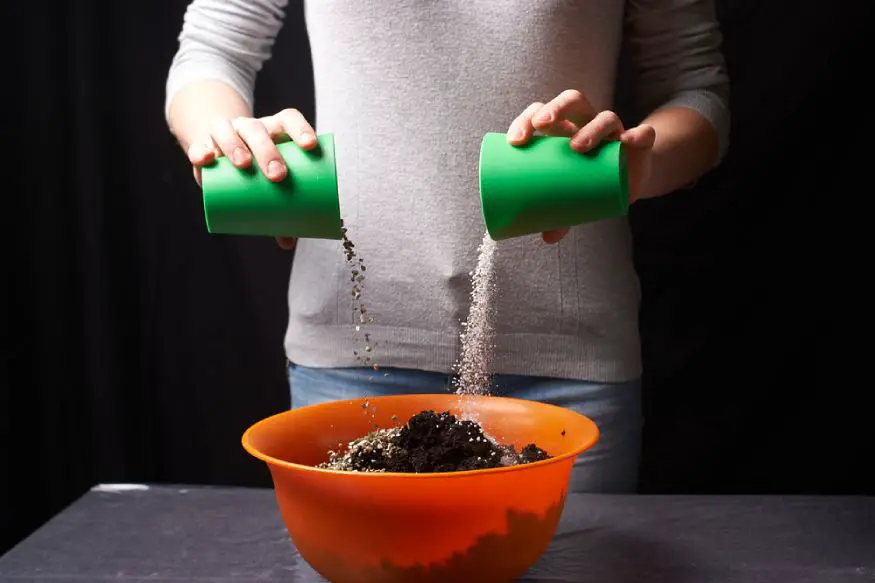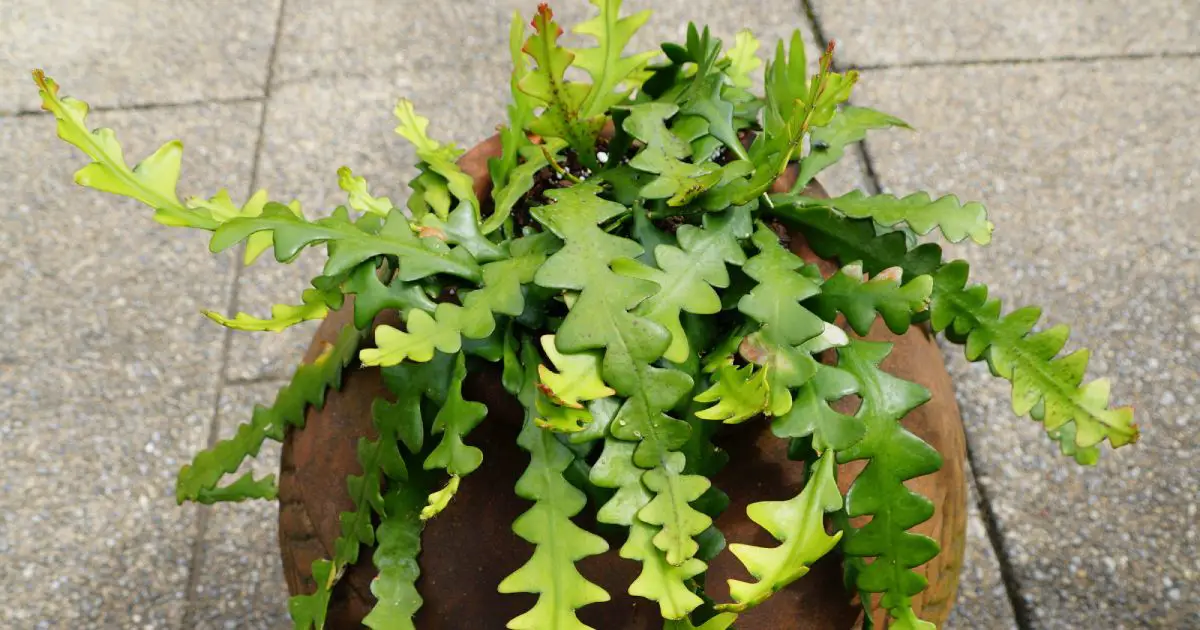The Fishbone cactus, otherwise known as zigzag cactus, orchid cactus, or ric rac cactus, is instantly identifiable by its unusual leaves. When you think of a cactus, you probably picture a thick-stemmed, leafless, spiky plant in the desert. The fishbone cactus is completely different, with slim, spike-free architectural leaves reminiscent of fern fronds.
Although most cacti originate in the desert, some other cacti (like fishbone cactus) are epiphytes. Epiphytes grow in tropical jungles, nestled into the shady crooks between a tree trunk and a limb. This means they don’t just look different than typical cacti, they have different care needs. Fortunately, as long as you know what they need, fishbone cacti are just as easy to take care of as their desert cousins.
Quick Care – Fishbone Cactus
| Botanical name (Family) | Disocactus anguliger, formerly known as Epiphyllum anguliger (Cactaceae family) |
| Sun requirements | Filtered or bright indirect light preferred |
| Hardiness/Zone | Hardy outdoors only in Zones 10-12 |
| Water needs | Moderate for a succulent (more than most cacti) |
| Toxicity | Believed to be non-toxic |
| Primary growth season | Spring through late summer; mature plants may flower in the fall if they experience a winter dormancy |
| Typical size at maturity | The leaves typically extend about six inches upward from the soil, then fold over and trail for up to three feet in length; however unpruned mature plants can grow much larger, with long corked stems |
Growing Requirements for Fishbone Cactus
In this section, we will go into more detail about the specific requirements for growing the Fishbone cactus.
Outdoor Placement

Fishbone cactus can be grown outdoors under certain circumstances, but for the most part they work much better as houseplants.
These cacti originated in the coastal and tropical regions of Mexico. They are epiphytic plants, meaning that they tend to grow in trees with long slender leaves that hang down, forming a trailing habit.
Note: Since they evolved to grow on tree limbs, they do not do well in most gardens’ dense, poorly draining soil. Loose, quickly draining soil is essential.
As you might expect of a jungle plant, fishbone cacti need consistently warm temperatures. Even temperatures in the 40s Fahrenheit can cause them to die back, so anywhere colder than USDA zone 10, they need to be grown in pots and brought inside for winter.
Although these plants are intolerant to cold, they are also intolerant to direct sunlight. Like other epiphytic plants that grow under the foliage of jungle trees, they prefer indirect or dappled sunlight. Direct sunlight, especially in the afternoon, will cause sunburn (permanent brown leaf discoloration).
Indoor Placement
One of the reasons fishbone cacti are such popular houseplants is that unlike most plants, including most succulents and especially desert cacti, they do not need or want full, direct sunlight.
This is an ideal plant for a north- or east-facing window. They will also typically do fine in locations where they only get bright indirect light. They may do okay in a limited-exposure west-or south-facing window if that’s your only option. However, if you see signs that the plant is beginning to sunburn, make sure to move it out of direct sunlight.
Pet Access
Although we have not found confirmation from our most trusted sources (such as ASPCA), the general consensus is that fishbone cactus is safer to eat than fishbones themselves. This plant is widely generally considered non-toxic, and in fact, the fruits of the plant are reportedly edible.
Container and Soil

Even though these are jungle plants, fishbone cacti don’t like to stay wet consistently. As you can imagine, growing up in a jungle tree, epiphytes are shielded from light rain by the plant’s canopy, so they get wet mainly during occasional deluges.
Since they root in bark rather than soil, their roots dry off quite quickly after the rain stops. That means to grow them successfully in a pot you need to use a very loose, well-draining potting mix and a pot with a good drainage hole.
Don’t use too big of a pot. Fishbone cacti prefer to be somewhat root bound. Plus, the smaller the pot, the less potting mix, so the faster the potting mix will dry out, which this plant appreciates.
Note: If your plant becomes too root-bound, the roots can block the drainage hole, especially in a short pot, so keep an eye out for that.

Since they have sprawling stems, which form a trailing habit, you can use a hanger plant. If you don’t want to use a hanging planter, a regular pot or planter is also fine, as long as it has a nice-sized drainage hole.
If your pot doesn’t have a drainage hole, you can use the ‘pot in a pot’ method, or you can drill a drainage hole in your pot. Otherwise, you will have to use more advanced watering techniques than the methods we usually recommend (basing your watering frequency on the pot’s weight, for example).
Note: Commercially available cactus/succulent-specific potting mixes will work okay for a fishbone cactus, but this plant will really benefit from a DIY potting mix blend.
It is much better than anything you’ll find at a big-box store and saves you money. It is also peat-free, which is better for the environment and can be better for your plant (peat can become hydrophobic over time).
We recommend using Our Favorite Succulent Mix recipe, which is coconut coir based. However, our Shortcut Succulent Mix recipe, which builds on a commercially available peat-based cactus mix base, would also work well for a spring cactus.
The key is adding coarse sand and perlite (or another gritty amendment like pumice) to make sure the soil drains well instead of retaining water. In the case of a fishbone cactus, you really can’t overdo the amount of grit included.
Watering
Even though this plant is from the jungle, not the desert, the biggest danger to your fishbone cactus is being forced to go for a swim. Like mostso succulents, these cacti need their roots to dry out between every watering. Otherwise, they are likely to develop root rot, which can attract other pests and diseases.
The best way to water your fishbone cactus is on an as-needed basis, rather than on a schedule. Ideally, you should wait until the soil in the top third of the pot has dried out completely before watering again.
When you water, we recommend using the “soak and dry” or “dunk and soak” methods. Test the soil for dryness every time, and don’t re-water until it passes the test.
If provided the right conditions, fishbone cacti will go through a dormant period beginning in the late fall and lasting most, if not all, winter. During this period, their water consumption needs will fall substantially.
Note: Make sure not to overwater at any time, but especially during a period of dormancy, when it may go a month or so without needing more water. Begin this period of reduced watering immediately after the plant flowers or in the late fall if the plant does not flower.
While most people don’t find it necessary to provide extra humidity, this plant will welcome a little extra moisture in the air. Just don’t water the plant too frequently as a substitute for airborne humidity.
Flowers

A mature fishbone cactus will produce beautifully aromatic, large, white, pink, red, or yellow flowers in the fall (depending on the cultivar). The flowers bloom in the evening, then die off quickly. The plant may flower in a couple of bursts, or on an ongoing basis for a few weeks. When your plant is finished flowering for the year (if it does flower), let it go dry for a few weeks to give the plant a break.
Like holiday cacti, fishbone cacti are unlikely to produce their fall flowers unless they go through a period of dormancy the previous winter. There are no guarantees, but three key factors tend to determine whether or not it will go dormant, all of which you can control.
Access to Sunlight
First, the plant’s access to sunlight should reflect the reduced daylight hours of winter. Do not provide artificial light (grow lights or regular indoor room lights) during the hours it is dark outside. Aim to give your plant at least 14 hours of darkness daily over the winter.
That may require you to move the plant so that it is not in a room (such as a bedroom) where the light is likely to be on in the evening or early morning.
Temperature
Second, temperature control is essential to winter dormancy. This plant cannot tolerate freezing (or even temperatures in the high 30s or low 40s for very long), but it does need cooler winter evening temperatures than many people prefer in their homes.
Nighttime temperatures in the 50s will allow the plant to go dormant without putting too much cold stress on it. A garage or sunporch, which is not heated but absorbs some heat from the house, may work well.
Watering Schedule
Finally, reduce your watering schedule. During winter dormancy, the plant will drink very little water. Watering too frequently will cause root rot and stress the plant.
In general, you should let the top third of the potting mix in your planter to get bone dry before soaking it again, which may take a month or more in the winter. If the plant’s leaves begin to shrivel or become floppier than usual, that’s a good sign it is overdue to be watered.
You can find our full guide on watering succulents here.
Fertilizer and Maintenance

Repot your fishbone cactus only as needed, every three to five years. They don’t mind being a bit root-bound, so as long as you’re fertilizing regularly and the roots aren’t blocking the drainage hole.
Note: Spring is a good time to repot, so you don’t risk damaging any flower buds that might grow in the late summer or fall.
It’s also a good idea to repot when you first bring your fishbone cactus home. By doing so, you can visually confirm that the roots are healthy and the pot contains an appropriate potting mix and adequate drainage.
We recommend replacing it with a mix that has a much higher ratio of sand and perlite compared to the amount of organic matter.
Since they prefer soil that is relatively low in organic matter, it’s a good idea to fertilize your fishbone cactus occasionally, but only occasionally. Over-fertilizing is not good for this plant. Fertilizer that is not absorbed by the plant can burn the roots.
In the first year after repotting a succulent with fresh potting mix, fertilizer is unnecessary. After that, once every other month in the spring and summer should be plenty.
The best fertilizer choice is an organic, liquid cactus-specific fertilizer. My go-to is Dr. Earth Organic & Natural Pump & Grow Succulence Cactus & Succulent Plant Food, but there are other reliable brands that make a similar product. If you do use an organic fertilizer formulated specifically for cacti or succulents, you can follow the package instructions in terms of dilution.
If you are using a chemical fertilizer not designed for succulents, make sure to dilute it to a quarter-strength, or at most half-strength, of what is indicated on the package instructions.
Note: Avoid any fertilizer that has an NPK ratio where the nitrogen (N) is higher than the phosphorus (P) or potassium (K).
An even balance is fine, or a fertilizer with lower nitrogen. Some people report good results from an annual application of orchid fertilizer or even a fertilizer designed for tomatoes (which tend to be high in phosphorus).
As your plant matures, it may develop corking (when the base of the stem becomes hard, brown, and woody). This is the plant’s strategy for strengthening the stems to bear the weight of longer, heavier leaves.
If you don’t like the look of it and you want to prune your fishbone cactus to improve its appearance, feel free to cut branches off near the base, ideally in the spring or early summer. One or more stems will regrow from the stump. You can propagate the pruned stems.
Propagation

Leaf/stem propagation of fishbone cactus is quite simple. It is best to prune and propagate your plant in the spring or summer. You can propagate cuttings at any time of year, but your mother plant may not respond as well to pruning during winter dormancy.
- Water your plant several days before propagating. This will allow the leaves to fill its water stores and give the cuttings the best chance of success.
- Use a sharp, sterile knife or clippers to remove one of your plant’s leaves. Cut it off near the base. Like a rosebush, it will regrow from that stump. Often multiple stems will emerge from the stump, which is great for helping your plant grow bushier. If you propagate a long branch, you can cut it down into multiple sections of around four inches each.
- Leave your cutting(s) on a plate or similar dry surface to cure for around a week before planting. You’ll know it is done curing when the cut area has formed a callus (it should look dry and healed, not raw and wet). During the curing process, keep the cutting out of direct sunlight and extreme temperatures.
- After that, simply stick the cured root-end of your cutting into a small pot full of damp potting mix, preferably our recipe for Seed Starting & Propagation Mix. Because this is a jungle cactus, keep the potting mix moist but not soggy. You can also provide a little extra humidity in the air around the plant while it takes root.
How long you’ll need to wait depends on many environmental factors, but generally, you can expect roots to develop within a few weeks and new growth to begin after several months.
If you’re new to this process, you can check out our guide for more tips on propagating your succulents. Just keep in mind that because these are jungle cacti, not desert cacti, they will benefit from more moisture during propagation than other succulents.
Common Fishbone Cactus Problems

Fishbone cacti are generally easy to grow and low-maintenance. However, there are a few problems to watch out for, as well as a few situations that may cause concern but are actually fine.
- No flowers: Fishbone cacti do not bloom until they are mature plants, and it is common for them to remain flowerless even in maturity when grown indoors. This is largely because indoor plants are less likely to go through winter dormancy. You can encourage them to flower by forcing a winter dormancy. Make sure that over the winter, they get at least 14 hours of darkness and temperatures in the 50s each night. However, many people grow this plant for its attractive foliage rather than the flowers, so it’s worth growing even if you don’t want to bother forcing a dormancy period.
- Stems are long and spindly: The stems of your fishbone cactus may grow leggy if it has inadequate access to sunlight. You can move it to a sunnier area to stop this from worsening, but it will not improve branches that have already stretched. If you don’t like the appearance, you can cut the stems off near the base and wait for the plant to regrow new leaves. You can propagate the stems you remove.
- Root rot: Water only as needed or when about a third of the plant’s potting mix has dried out. Then use an appropriate watering method. If the root rot is substantial, you may need to remove the plant from its pot, cut off any damaged leaves, and repot using better-draining soil and a pot with a good drainage hole.
- Brown patches on leaves: This is likely sunburn, due to exposing the plant to direct sunlight. Move the plant somewhere that it will only receive bright indirect light or dappled sunlight.
- Flaccid leaves: If your plant’s leaves become wrinkled and soft, it is a good sign it needs to be watered. The leaves change in this way because the plant has used up most of its stored water reserves.
- Pests – While generally resilient, a fishbone cactus can develop a mealybug or aphid infestation. If your cactus is buggy, check out our guide to identifying and eliminating these pests.
- “Hair” growth – Occasionally fishbone cacti grow small brown hair-like tendrils. These are aerial roots, which capture moisture from the air. They are nothing to worry about.
For more information, check out our guide to diagnosing and curing your ailing succulent.
If You Don’t Have One Yet, Go Fish(bone Cactus)
Even though fishbone cacti originate in the jungle instead of the desert, they are just as easy to care for and resilient to pests and diseases as other cacti. In fact, because they don’t need direct sunlight like most cacti, they’re among the easiest to grow in any household, leaving your precious south-facing windowsill space available for more demanding plants.
So, whether you want unusual foliage, fragrant flowers, or just a plant that thrives on neglect, zig-zag your way over to your local florist and pick up a fishbone cactus.


